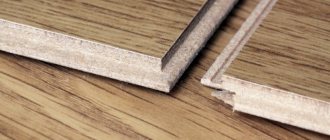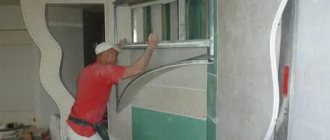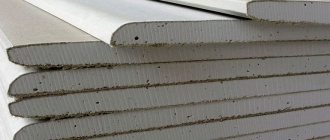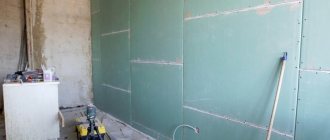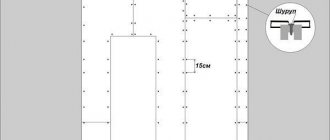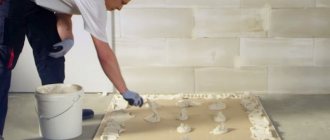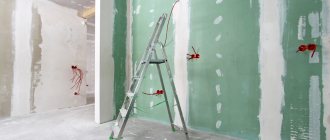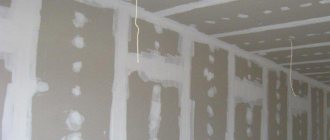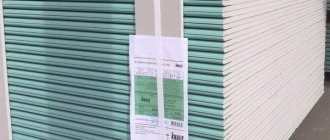The structure of conventional drywall contains gypsum filler combined with a compacted cardboard sheathing. This type of gypsum board is used for finishing dry rooms, for example, ordinary rooms in a house, office premises. Ordinary drywall is very convenient to use, has a light weight of the drywall sheet and is economical in price.
Fire-resistant plasterboard, such as PLATÓ Vognestop board, is ideal for areas with a high fire hazard. Thanks to these features of the material, smoke and fire will not be able to instantly spread throughout the room.
It is suitable for auxiliary summer buildings, places near stoves, fireplaces and other heat sources. GKLO is in demand for creating fireproof partitions; it is used to line ventilation, cable ducts, and shafts.
Moisture-resistant plasterboard is mainly used for finishing kitchens, bathrooms, balconies and other rooms where the humidity level is above average. The structure of gypsum board contains elements that are resistant to moisture levels up to 75%, while the material itself does not deform and does not lose its original properties. This type of drywall is more expensive than regular drywall, but its practicality will compensate for all the expenses over time.
Fire-moisture resistant drywall is not susceptible to moisture, fire or elevated temperatures. This type of plasterboard is used for finishing special premises and country houses. Regular drywall is light gray, fire-resistant drywall is red, and moisture-resistant drywall is green or blue.
In addition to the main types of drywall, there is also designer plasterboard or arched, flexible. It is actively used to create creative decorative elements. Thanks to its flexibility and unique properties, this building material serves as an excellent basis for fashionable design structures.
Application of material
Drywall is considered a universal material. Used for the following works:
- creating partitions;
- construction of various structures;
- closing openings;
- insulation and leveling of surfaces;
- creating relief elements;
- surface finishing;
- repair and finishing of finished structures.
The size of the plasterboard sheet and its immediate purpose completely depends on the purpose. It can be moisture- and fire-resistant, ceiling, wall, arched.
Panel dimensions
The standard dimensions of the panels are 2.5x1.2 meters (LxW), with an average thickness of 12.5 mm. Weight is about 29 kg, and the area is 3 m². There are other size options. For example, the length is more than 3 meters, and the thickness of the panels is 6.5-12.5 mm. The only indicator that does not change is the width - 1.2 m, although special panels can have a thickness of 0.6 m.
The dimensions of the panels are determined by their direct purpose Source izgipsokartona.com
Sheets are:
- Wall . Length 2/2.5/3 m, thickness the same - 12.5 mm, weight 22.3/27.9/33.5 kg. It has the optimal thickness to implement many ideas. Used for working with walls and creating various structures.
- Moisture resistant . 2/2.5/3 m long, thickness – 12.5 mm, weight 22.3/3.3/36.3 kg. Used when indoor humidity is high (up to 85%). They contain special silicone and modifiers. The top is treated against mold. Moisture resistance may increase when using other materials.
- Ceiling . Length 2/2.5 m, plasterboard thickness only 8/9.5 mm, weight 17.5/21.9 kg. A lightweight version of conventional panels. Designed to reduce overall structural weight. This allows you to save on the profile and make a larger frame pitch, reducing the cost of the entire system.
Ceiling plasterboard Source sdelaipotolok.com
- Arched . Length 2/3 m, standard thickness - 6.5 mm, weight 18 or 21.6 kg. It is used to create interior openings in the form of arches. The thinnest drywall, so it can bend to almost any radius.
- Fire resistant . Available in only one version: length 2.5 m, thickness 12.5-25 mm, weight 30.6 kg. Special impregnation and additives are used in gypsum. The sheet can withstand the influence of open fire for 20 minutes. For rooms with temperatures above normal and where there is an open fire.
The dimensions of the plasterboard sheets (length, height, and thickness) depend on the purpose of the panels. You should always follow the manufacturer's recommendations.
General information and characteristics of the main types of drywall
The material used in “dry” construction technology, the smooth surface of which is easy to paint, wallpaper and ceramic tiles, consists of a core with external cardboard reinforcement of both planes and edges along the length of the sheet. The core material is gypsum. To obtain certain properties of a plasterboard sheet, special additives are mixed into the gypsum.
For all brands, the mass distribution of constituent materials is within the following limits:
- 90%-94% – gypsum;
- 4%-6% – reinforcing cardboard;
- 1%-2% – other components and special additives.
In the nomenclature of most plasterboard manufacturers, the main types of sheet material are:
- GKL is an ordinary plasterboard sheet (can also be called standard, construction, basic). This is the most popular and widely used type of material for interior work in rooms with low humidity. Suitable for installation on all types of surfaces: vertical, horizontal, curved. A regular sheet can be easily identified by the gray color of the cardboard layer. The standard size of drywall for gypsum board sheets has the following parameters, mm: 2700 (length) x 1200 (width) x 9.5 (thickness).
- GKLV is a marking of moisture-resistant drywall, used in all cases as gypsum board, and also suitable for furnishing premises with an expected humidity of up to 85%. During the production of the material, hydrophobic modifiers and silicone granules are added to gypsum, which reduce moisture absorption. The surface of the gypsum board is treated with anti-fungus and mold agents. The resistance of the material to moisture is increased by additional coatings after installation: paint, ceramic tiles, a layer of waterproofing, water-repellent primer, plastic panels. In addition to standard use, waterproof plasterboard is suitable for kitchens, bathrooms, insulated loggias, attic rooms, showers, and swimming pools. Cardboard color is green. 2500x1200x12.5 mm - the size of a sheet of gypsum plasterboard, which is considered standard.
- GKLO - this is the designation for fire-resistant plasterboard sheet. Special additives for gypsum and impregnation of cardboard (of which there are several layers in this material) with special compounds allow the material to dry for up to 20 minutes. withstand the pressure of an open flame. GKLO helps to protect walls and ceilings near fireplaces and stoves, in saunas, baths and boiler rooms, ducts with installed wiring, attics and other high-risk rooms. Fire-resistant sheets are in demand for organizing partitions and covering surfaces in offices, premises of public organizations, and enterprises. When choosing, you should take into account the higher cost and weight of the material. Cardboard sheets have pink color shades. The standard size of a plasterboard sheet is the same as gypsum board.
Special purpose gypsum boards
In addition to the options common on the market, there are panels for special purposes:
- Gypsum fiber . Cellulose fibers are added to gypsum. Such panels are used to install various floor coverings; they can be used outside buildings, as well as in rooms with constant high moisture.
Gypsum fiber panels Source mr-build.ru
See also: Catalog of companies that specialize in finishing materials and glazing.
- Flexible panels . They are also called designer ones. The thickness of such panels is only 6 mm. They are used only to create wave-like structures, as well as to create arches with a very large degree.
- High strength sheets . These sheets are very durable compared to any other analogues. Increased strength is achieved by reinforcing the panels with fiberglass and multi-layer cardboard.
- Facade sheets . These panels are designed specifically for finishing facades. Their distinctive feature is that they easily tolerate any atmospheric changes, including sudden changes in temperature, long-term exposure to frost and sunlight.
- GKLVO. Such panels have all the characteristics of both fire-resistant and moisture-resistant sheets.
In addition, you can find panels on the market that can shield X-ray radiation. At the same time, they additionally provide increased protection from noise, thermal insulation, and conduct heat. There are laminated, acoustic and restoration panels.
Acoustic drywall
Acoustic plasterboard has increased sound insulation and is widely used for finishing shops, concert halls, dance and recording studios, and bedrooms. Acoustic plasterboard differs from universal plasterboard in that holes with a diameter of about 1 cm are made in its surface, and on the back side the sheet is covered with a special sound-absorbing coating that absorbs sound waves well. Acoustic drywall can be painted, but cannot be puttied, so as not to affect its soundproofing properties.
Panel weight
The weight of the panel depends on the thickness, length and width. In this case, the thickness of the plasterboard for the wall (as well as other options) depends on the purpose of the panels. According to the standard, the weight of a fire-resistant panel sheet should be 1.6 kg per 0.8 mm; for moisture-resistant and ordinary sheets, this figure should be a maximum of 1 kg per 1 mm of panel.
The thickness of the panel determines its weight and purpose Source izgipsokartona.com
It is necessary to know the weight of the slab to calculate the load force of the installed structure. It is very important to know the maximum weight the panel you are using can support. This will avoid any defects or even collapse of the structure when operating conditions change. When working with material, it is necessary to correctly calculate the load on each square meter. This is especially true in cases where it is necessary to install blind panels or mount heavy elements. You can achieve a load of up to 150 kg/1m2.
Installation Features
If plasterboard is mounted on flat walls, then it can be attached with a special mounting adhesive, which is based on gypsum.
To overcome various differences and irregularities, a different, more thorough approach is required. The first step is to fix a frame made of a metal profile or wooden slats with a thickness of 2-2.5 mm to the wall. After this, you need to attach the drywall to it using simple screws, but you need to pre-drill the holes for the screws.
To create a concave or convex design, you must first wet the drywall and firmly fix it to the template until it is completely dry. To help water penetrate inside better, you can use a special roller with metal needles. It is necessary to roll the bend with a roller, pressing it very tightly against the surface of the drywall so that the needles make a large number of holes. After this, you need to place a damp cloth over the entire surface with holes. To avoid breaking the sheet, it is necessary to wet the fabric several times after it has completely dried.
You should leave gaps of 3-5 mm between the sheets, and then putty them. To prevent cracks from appearing at the joints, the sheets must be placed so that the joints fall on the profile, and before puttying, the joints themselves must be glued with sickle tape or a construction bandage.
To attach wall and ceiling lights, cabinets and shelves, you must use special dowels. They should be selected based on the thickness of the plasterboard sheet and the weight of the load (6 kg per 1 m2). If you need to secure a heavier load, then during the creation of the frame it is necessary to fix an additional metal strip in those places where the load will hang.
Calculation of the required number of panels
Knowing the dimensions of the panels is required in order to correctly determine the number of panels for carrying out certain planned repairs. The size of the sheet is determined after taking all measurements. For example, for rooms where the wall height is 2.7 m, three-meter panels are purchased. A 0.3 m strip is cut from them. It is incorrect to use 2.5 m panels with the addition of 0.2 m strips. This only increases the number of seams, profiles and, accordingly, costs.
Correct calculation of ceiling panels Source sdelaipotolok.com
Correctly sized panels ensure correct installation of the frame, strengthening the structure and reducing the time of repair work.
It is necessary to avoid in every possible way a large number of seams when working with this material. This means that when purchasing panels, it is necessary to correctly determine the required length, as well as correctly place them on the frame and the plane as a whole.
You can purchase sheets based on the area of the entire surface that will be processed. But in this case, you will need to take approximately 10-20% of spare panels. These are additional and unreasonable costs that can be avoided if you know the dimensions of the sheets and make the appropriate calculations.
How to distinguish sheets correctly
Let's learn how to accurately determine what kind of “gypsum” we will be dealing with based on the intended purpose of the varieties of gypsum boards and their specific properties.
Despite the fact that there are many manufacturers of the products in question on the market, they all adhere to approximately the same marking of their products, which consists of the corresponding tinting of the cardboard shell and stamped symbols. Define sheets:
— Wall gray with blue markings; — Moisture-resistant green with blue markings; — Fire-resistant pink or gray, with red markings; — Moisture-resistant green with black markings.
Types of longitudinal edge profiles of plasterboard sheets
The passport (labeling) of each product can be read on its reverse or end part. Useful information includes: manufacturer, sheet and edge type, overall dimensions, production date and production standard.
Transcript example
KNAUF SHEET GKLV-UK 12.5x1200x2500 12/12/15 GOST 6266-97
, means: Manufacturer - Knauf;
Sheet type – moisture resistant; Edge UK – “boat”, thinned (PC – straight, PLC – semicircular, PLUK – semicircular thinned, ZK – rounded); Dimensions – thickness 12.5 mm , width 1200 mm , length 2500 mm ; Release date – 12/12/15 ; Production standard - GOST 6266-97
Briefly about the main thing
The dimensions of the gypsum board sheet are a very important indicator when working with drywall.
It is very important to choose the right panels to get a high-quality and durable result.
Some panels are interchangeable, but they may not give the required result.
Always follow the recommendations of manufacturers and craftsmen.
Try to avoid a large number of seams, plan the placement of sheets correctly.
Ratings 0

